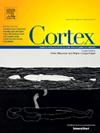Using unsupervised dimensionality reduction to identify lesion patterns predictive of post-stroke aphasia severity
IF 3.3
2区 心理学
Q1 BEHAVIORAL SCIENCES
引用次数: 0
Abstract
Although voxel-based methods consistently identify brain regions associated with specific language functions, these techniques are limited when applied to broader behavioral measures. To better represent effects of lesions on distributed brain regions, we used a data-driven approach called non-negative matrix factorization (NMF) to identify representative stroke patterns and explore associations with aphasia severity. Lesions were segmented using structural MRIs for 107 left hemisphere stroke patients, and the Western Aphasia Battery - Revised Aphasia Quotient (AQ) was used to quantify aphasia severity. Percent spared tissue was calculated in left hemisphere white and gray matter regions. By applying NMF to spared tissue data, we identified 5 NMF ‘atoms’ which represent prototypical stroke patterns across this dataset. Linear regression was used to identify whether certain stroke patterns were associated with aphasia severity, adjusted for lesion volume and demographics. Two NMF atoms showed relevance in predicting AQ: strokes with low spared tissue across the whole MCA territory were associated with more severe aphasia, but strokes with high spared tissue around the insula were associated with less severe aphasia. We also identified a pattern of high spared tissue in superior fronto-parietal regions, where lesion volume was more strongly associated with severity as a result of isolating damage to more critical language areas. These representative stroke patterns offer a new way to combine information about lesion burden and location and explore anatomical associations with language dysfunction in stroke.
使用无监督降维识别预测中风后失语严重程度的病变模式
尽管基于体素的方法始终能够识别与特定语言功能相关的大脑区域,但这些技术在应用于更广泛的行为测量时受到限制。为了更好地描述病变对分布式脑区域的影响,我们使用了一种称为非负矩阵分解(NMF)的数据驱动方法来识别具有代表性的卒中模式,并探索与失语严重程度的关联。对107例左半球脑卒中患者的病变进行结构核磁共振成像(mri)分割,并使用Western Aphasia Battery - Revised Aphasia Quotient (AQ)来量化失语的严重程度。计算左半球白质和灰质区域的剩余组织百分比。通过将NMF应用于备用组织数据,我们确定了5个NMF“原子”,它们代表了该数据集中的原型中风模式。线性回归用于确定某些中风模式是否与失语严重程度相关,并根据病变体积和人口统计学进行调整。两种NMF原子在预测AQ方面显示出相关性:整个中脑区有低备用组织的中风与更严重的失语症有关,但岛周围有高备用组织的中风与较轻的失语症有关。我们还发现,在额顶叶上部区域,由于对更关键的语言区域的隔离损伤,损伤体积与严重程度的关系更强。这些具有代表性的脑卒中模式提供了一种新的方法,可以将损伤负荷和部位信息结合起来,探索脑卒中中语言功能障碍的解剖学关联。
本文章由计算机程序翻译,如有差异,请以英文原文为准。
求助全文
约1分钟内获得全文
求助全文
来源期刊

Cortex
医学-行为科学
CiteScore
7.00
自引率
5.60%
发文量
250
审稿时长
74 days
期刊介绍:
CORTEX is an international journal devoted to the study of cognition and of the relationship between the nervous system and mental processes, particularly as these are reflected in the behaviour of patients with acquired brain lesions, normal volunteers, children with typical and atypical development, and in the activation of brain regions and systems as recorded by functional neuroimaging techniques. It was founded in 1964 by Ennio De Renzi.
 求助内容:
求助内容: 应助结果提醒方式:
应助结果提醒方式:


